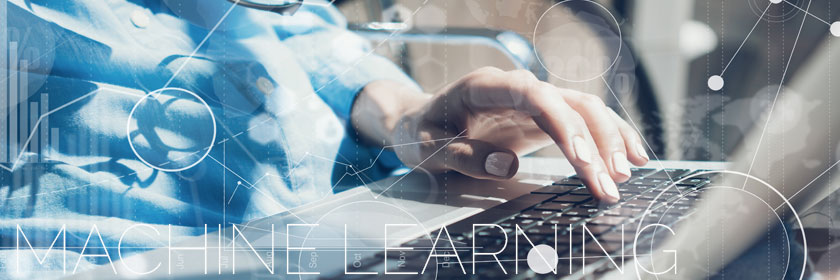Machine Learning is actually a data analytics technique. It consists of algorithms that use computational methods to "learn" information directly from data without relying on a predetermined equation as a model. It is also a concept which allows the machine to learn from examples and experience, and that too without being explicitly programmed.
This can be detailed further with a real life instance. Through data mining, an organization or businesses can collect information on the different types of human expressions. That is, how a human or specifically a customer reacts to each product/service or each situation. This data can be fed into a machine or system that operates on Artificial Intelligence. The machine will then automatically know what to do next, if it sees one of such expressions. Hence machines are trained to do as instructed.
In more precise terms, Machine Learning is the first step to be implemented before the adaptation of artificial intelligence in businesses. The biggest advantage of machine learning in the corporate sector is the ability to make automated decisions without taking risks in any manner. More advantages include:
Personalization of Customer Services: The core objectives of every commercial establishment or professional agency to effectively improve the quality of customer service and reduce cost of investment while continuing to generate steady profits. Machine Learning provides genuine solutions to help businesses achieve these objectives. This is done by combining all data gathered in customer interactions with natural language processing technology. Hence, the collection of inputs related to the moods of customers, product/service preferences and details of financial transactions among other data can be used in AI technologies to further personalize customer services.
Automated Recruitment: Hiring, recruitment and training processes have always been cumbersome for companies and agencies of different sectors. Difficulties in finalizing the right candidates, riddance of human biases, interview patterns, and maintaining cost effectiveness have presented troubles for recruiters. Machine Learning can be of help here as it brings automation to recruitment processes. Any corporate or employer can screen and interview thousands of candidates if not more, within the shortest period of time. Not a single candidate will be overlooked and there will not be any human bias such as preferences of color, language or political affiliation in the selection processes. The best ones will be hired on the condition set by the employer.
Finance Management: Along with cost optimization, managing finances is an important aspect of every professional organization or department. This includes the estimation of capital requirements, allocation of funds, distributing payrolls, and management of liquid money such as cash among others. Manual entry of such details and/or human handling of these inputs in computer systems are always prone to errors. Besides, the absence of enough manpower at any given point of time or temporary malfunctioning of physical computer systems can delay the process. Machine Learning solves these issues by automatically managing all financial processes of a company on a single platform. A business can reduce their efforts and time on managing their finances and save a lot of cash too. Plus, the security of machine learning technologies provides protection to the processes at the same time.
How does it work?
Machine learning uses two types of techniques. These are supervised learning and unsupervised learning. Supervised learning indicates teaching or training the machine, using data which is well labeled. That is, a machine is learnt to respond in a particular way to data that is already tagged with the correct answer. After that, machine is provided with new set of (data) so that supervised learning algorithm analyses existing responses and can predict future outputs.
The next is unsupervised learning, which finds hidden patterns or intrinsic structures in input data. This means inputs are given to the machine, but algorithms are given the freedom to find their own responses. The main aim of unsupervised learning is to model distribution in data in order to learn more about the data.
A real life description about the difference between supervised and unsupervised learning can be made in the example of assembling of fruits in a basket. Suppose there are a mixed bunch of fruits on a table. A machine should be instructed to only take apples from the pile and deposit them into the basket. Inputs may be given to the machine about the color, texture, scent, and size of an apple; perhaps even the image of an apple. Based on this, the machine will automatically organize them. This is supervised learning.
In another instance, the machine isn't given any information about an apple. Here the machine has to learn one-feature at a time. Instructions can be first given to list fruits belonging to particular color; red. The machine will then list all fruits having the color red which can include apples and strawberries. Next the machine is given instructions to group fruits that are red in color and big in size. With this, the machine will correctly assemble apples in the basket. This is called unsupervised learning as the machine learns by itself without detailed inputs in the first place.
Machine Learning Solutions
Machine learning can provide several advantages such as rapid processing, analysis and prediction to any professional establishment. This concept also enables a company to deliver new products and services by lowering the cost of existing products. SGS Technologie has commenced its venture into the field of machine learning and artificial intelligence; our services are being welcomed in the industry. SGS’ machine learning solutions include:
- Algorithm Design
- Data Modeling
- Artificial Intelligence Consulting Services
- Blockchain Services
SGS invites you for discussions on any of our machine learning services.

<script type="application/ld+json">
{
"@context" : "http://schema.org",
"@type" : "Article",
"name" : "Machine Learning; what it means for you?",
"author" : {
"@type" : "Person",
"name" : "majestic"
},
"image" : "https://www.sgstechnologies.net/sites/default/files/2020-01/blog-img-mc.jpg",
"articleSection" : "Machine Learning is actually a data analytics technique. It consists of algorithms that use computational methods to �learn� information directly from data without relying on a predetermined equation as a model. It is also a concept which allows the machine to learn from examples and experience, and that too without being explicitly programmed.",
"articleBody" : "This can be detailed further with a real life instance. Through data mining, an organization or businesses can collect information on the different types of human expressions. That is, how a human or specifically a customer reacts to each product/service or each situation. This data can be fed into a machine or system that operates on Artificial Intelligence. The machine will then automatically know what to do next, if it sees one of such expressions. Hence machines are trained to do as instructed.</P>\n\n<P>In more precise terms, Machine Learning is the first step to be implemented before the adaptation of artificial intelligence in businesses. The biggest advantage of machine learning in the corporate sector is the ability to make automated decisions without taking risks in any manner. More advantages include:</P>\n\n<P><STRONG>Personalization of Customer Services:</STRONG> The core objectives of every commercial establishment or professional agency to effectively improve the quality of customer service and reduce cost of investment while continuing to generate steady profits. Machine Learning provides genuine solutions to help businesses achieve these objectives. This is done by combining all data gathered in customer interactions with natural language processing technology. Hence, the collection of inputs related to the moods of customers, product/service preferences and details of financial transactions among other data can be used in AI technologies to further personalize customer services.</P>\n\n<P><STRONG>Automated Recruitment: </STRONG>Hiring, recruitment and training processes have always been cumbersome for companies and agencies of different sectors. Difficulties in finalizing the right candidates, riddance of human biases, interview patterns, and maintaining cost effectiveness have presented troubles for recruiters. Machine Learning can be of help here as it brings automation to recruitment processes. Any corporate or employer can screen and interview thousands of candidates if not more, within the shortest period of time. Not a single candidate will be overlooked and there will not be any human bias such as preferences of color, language or political affiliation in the selection processes. The best ones will be hired on the condition set by the employer.</P>\n\n<P><STRONG>Finance Management: </STRONG>Along with cost optimization, managing finances is an important aspect of every professional organization or department. This includes the estimation of capital requirements, allocation of funds, distributing payrolls, and management of liquid money such as cash among others. Manual entry of such details and/or human handling of these inputs in computer systems are always prone to errors. Besides, the absence of enough manpower at any given point of time or temporary malfunctioning of physical computer systems can delay the process. Machine Learning solves these issues by automatically managing all financial processes of a company on a single platform. A business can reduce their efforts and time on managing their finances and save a lot of cash too. Plus, the security of machine learning technologies provides protection to the processes at the same time.</P>\n\n<H2>How does it work?</H2>\n\n<P>Machine learning uses two types of techniques. These are <STRONG>supervised learning</STRONG> and unsupervised learning. Supervised learning indicates teaching or training the machine, using data which is well labeled. That is, a machine is learnt to respond in a particular way to data that is already tagged with the correct answer. After that, machine is provided with new set of (data) so that supervised learning algorithm analyses existing responses and can predict future outputs.</P>\n\n<P>The next is <STRONG>unsupervised learning</STRONG>, which finds hidden patterns or intrinsic structures in input data. This means inputs are given to the machine, but algorithms are given the freedom to find their own responses. The main aim of unsupervised learning is to model distribution in data in order to learn more about the data.</P>\n\n<P>A real life description about the difference between supervised and unsupervised learning can be made in the example of assembling of fruits in a basket. Suppose there are a mixed bunch of fruits on a table. A machine should be instructed to only take apples from the pile and deposit them into the basket. Inputs may be given to the machine about the color, texture, scent, and size of an apple; perhaps even the image of an apple. Based on this, the machine will automatically organize them. This is supervised learning.</P>\n\n<P>In another instance, the machine isn�t given any information about an apple. Here the machine has to learn one-feature at a time. Instructions can be first given to list fruits belonging to particular color; red. The machine will then list all fruits having the color red which can include apples and strawberries. Next the machine is given instructions to group fruits that are red in color and big in size. With this, the machine will correctly assemble apples in the basket. This is called unsupervised learning as the machine learns by itself without detailed inputs in the first place.</P>\n\n<H2>Machine Learning Solutions</H2>\n\n<P>Machine learning can provide several advantages such as rapid processing, analysis and prediction to any professional establishment. This concept also enables a company to deliver new products and services by lowering the cost of existing products. SGS Technologie has commenced its venture into the field of machine learning and artificial intelligence; our services are being welcomed in the industry. SGS� machine learning solutions include:</P>\n\n<UL>\n\t<LI>Algorithm Design</LI>\n\t<LI>Data Modeling</LI>\n\t<LI>Artificial Intelligence Consulting Services</LI>\n\t<LI>Blockchain Services</LI>\n</UL>\n\n<P>SGS invites you for discussions on any of our machine learning services.",
"url" : "https://www.sgstechnologies.net/blog/machine-learning-what-it-means-you",
"publisher" : {
"@type" : "Organization",
"name" : "SGS"
}
}
</script>










